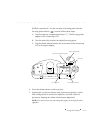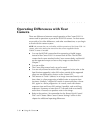
. . . . . . . . . . . . . . . . . . . . . . . . . . . . .
Using the Camera 5-17
Lenses behave somewhat differently with the EOS
•
DCS than with a
conventional EOS 35mm SLR. The exact details appear in the Specifi-
cations appendix.
You will not be able to shoot when the camera is in One Shot AF
mode if the camera cannot focus. Choose another focus mode, or take
some other action. (Refer to “3. Difficult Subjects for Autofocus,” in
the supplied EOS-1 N Instructions.)
A frame line indicating the actual picture area has been added to the
pre-installed focusing screen to match the size of the picture that will
be recorded by the CCD imager. Frame the scene within this rect-
angle.
Custom Functions 1 and 2 (film related) must be set to zero.
Battery check information displayed in the camera top LCD panel
should be ignored; instead, use the camera back LCD battery level
indicator.
The “ON” (I) setting of the EOS
•
DCS power switch corresponds to the
EOS-1 N “A” setting and the “OFF” (O) setting corresponds to the “L”
setting. Set Custom Function 3-1 to obtain the
)
)
)
setting (for in-focus
beeper).
The camera top LCD frame counter displays a reference number for
the picture you have just taken rather than the next picture you will
take. The reference numbers cycle from 1 to 39 and then repeat.
Check the camera back LCD panel to determine the number of
exposures remaining on the PCMCIA card.
WARNING: Do not connect a non-dedicated electronic flash unit to
the camera (hot shoe or PC terminal) without verification from a
Canon authorized service facility that the flash unit is compatible with
the camera body. Some electronic flash units will damage the camera
body unless they are isolated with an IR slave or a radio slave. Check
with a Canon authorized service facility for compatible equipment.
(Refer to the Chapter 7 for additional information.)


















